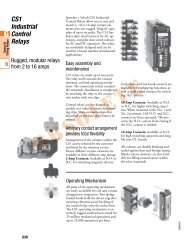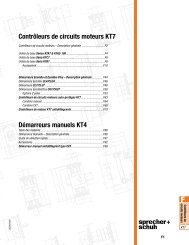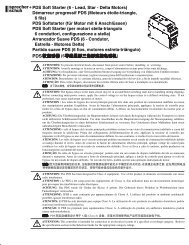Methods of Applying Circuit Protection - E-Catalog - Sprecher + Schuh
Methods of Applying Circuit Protection - E-Catalog - Sprecher + Schuh
Methods of Applying Circuit Protection - E-Catalog - Sprecher + Schuh
Create successful ePaper yourself
Turn your PDF publications into a flip-book with our unique Google optimized e-Paper software.
<strong>Circuit</strong> <strong>Protection</strong> <strong>Methods</strong>Series L9 UL489 Miniature <strong>Circuit</strong> Breakers<strong>Applying</strong> L9 UL489 Miniature <strong>Circuit</strong> Breakers in accordance with UL & NEC Guidelines (continued)DescriptionL9 <strong>Circuit</strong> Breakers for Branch <strong>Circuit</strong> protection are available one (1)-,two (2-), and three (3-) pole construction and are rated 0.5 to 63A at240VC AC and 0.5 to 40A at 480Y/277V AC (D Curve to 35A) forNorth American applications (UL 489 and CSA 22.2 No. 5.1). For IECapplications, the products are rated 415V AC 0.5 to 63A.Thermal Magnetic <strong>Circuit</strong> BreakersThe L9 Thermal Magnetic <strong>Circuit</strong> Breakers are general-purpose devicessuitable for the majority <strong>of</strong> industrial, inverse time circuit breaker applications.They combine thermal and magnetic trip actions and provideaccurate overload and short-circuit protection for conductors and connectedequipment.<strong>Circuit</strong> Breaker Application InformationSelection <strong>of</strong> a L9 circuit breaker with appropriate circuit protectionincludes consideration <strong>of</strong>:● <strong>Circuit</strong> Voltage● <strong>Circuit</strong> Frequency● Available Short <strong>Circuit</strong> Current● Continuous Current Rating● Application Considerations● Special Operating ConditionsAvailable Short <strong>Circuit</strong> CurrentThe L9 circuit breakers should only be applied in those applications inwhich the available short-circuit (or fault) current is less than or equal to10 kA (US/Canada) and 15 kA (IEC).Region Max. Voltage Current Range253V AC (1-pole)0.5...63A440V AC (2-/3-pole)IEC Regions48V DC (1-pole)0.5...63A96V DC (2-/3-pole)240V AC0.5...63ANorth America (UL 489& CSA 22.2 No. 5.1)480Y/277V AC 0.5...40A (D Curve to 35A)1-pole 48V DC2-pole 96V DCTripping Characteristics0.5...63A0.5...63AThe trip curve characteristics are shown on the following pages. Thetrip bands shown for each breaker represent current tripping limits for acircuit breaker and are within the limits established by UL.The standard tripping characteristic for L9 circuit breakers is Type C.Type C has a magnetic trip activated at 5-10 times the rated current <strong>of</strong>the circuit breaker. The reference temperature for the thermal trippingcharacteristics is 30 °C. The Type C characteristic will suit most applications.M<strong>Circuit</strong> <strong>Protection</strong><strong>Circuit</strong> VoltageThe L9 circuit breakers are rated by voltage class. Applications should notexceed the listed voltage and current range.<strong>Circuit</strong> FrequencyThe L9 circuit breakers may be applied to frequencies <strong>of</strong> 50 and 60 Hzwithout derating. For applications above 60 Hz, contact <strong>Sprecher</strong> + <strong>Schuh</strong>with specific application information for the derating <strong>of</strong> the circuit breakers.In rare occurrences when the Type C characteristic does not fully meetthe application, Type D magnetic trip characteristic is available, allowingfor transients approximately twice as high as the standard Type C.For a specific current at 30 °C, a circuit breaker will open ("clear the circuit")automatically at some total time that will be within the minimumand maximum time shown on the curves. For example, a one-pole, 15 A,L9 circuit breaker trips in not less than 1 s and not more than 200 s ona 30 A current. Because the UL standard defines this time spread, usersshould not specify exact tripping time. The lower current portion <strong>of</strong> thecurves (upper left) depicts the time to trip due to thermal action andreflect overload protection <strong>of</strong> the wire and connect load. The higher currentportion <strong>of</strong> the curves (lower right) depicts the trip due to magneticaction <strong>of</strong> the circuit breaker and reflects protection due to short circuitlevel currents.M36visit www.sprecherschuh.com/ecatalog for the most up to date informationSSNA2014


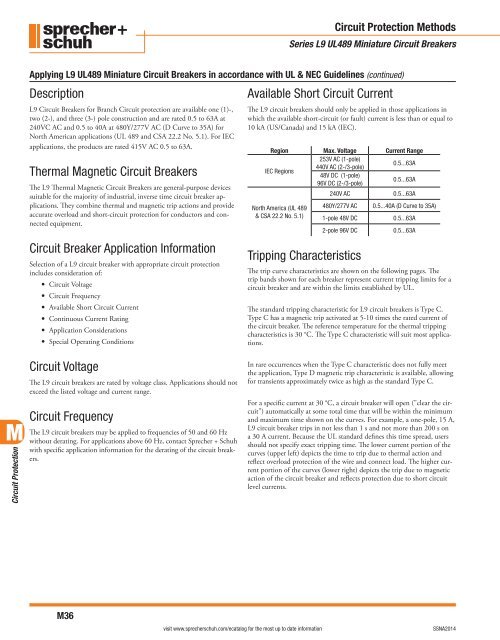
![Download Terms & Conditions of Sale [PDF] - Sprecher + Schuh](https://img.yumpu.com/51208389/1/190x245/download-terms-conditions-of-sale-pdf-sprecher-schuh.jpg?quality=85)

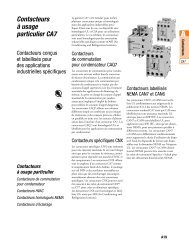


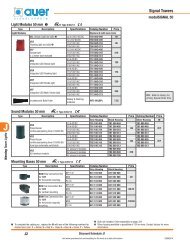
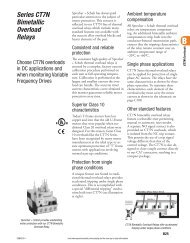
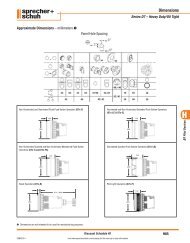
![PF Softstarter User manual [PDF] - Sprecher + Schuh](https://img.yumpu.com/48207512/1/190x245/pf-softstarter-user-manual-pdf-sprecher-schuh.jpg?quality=85)

